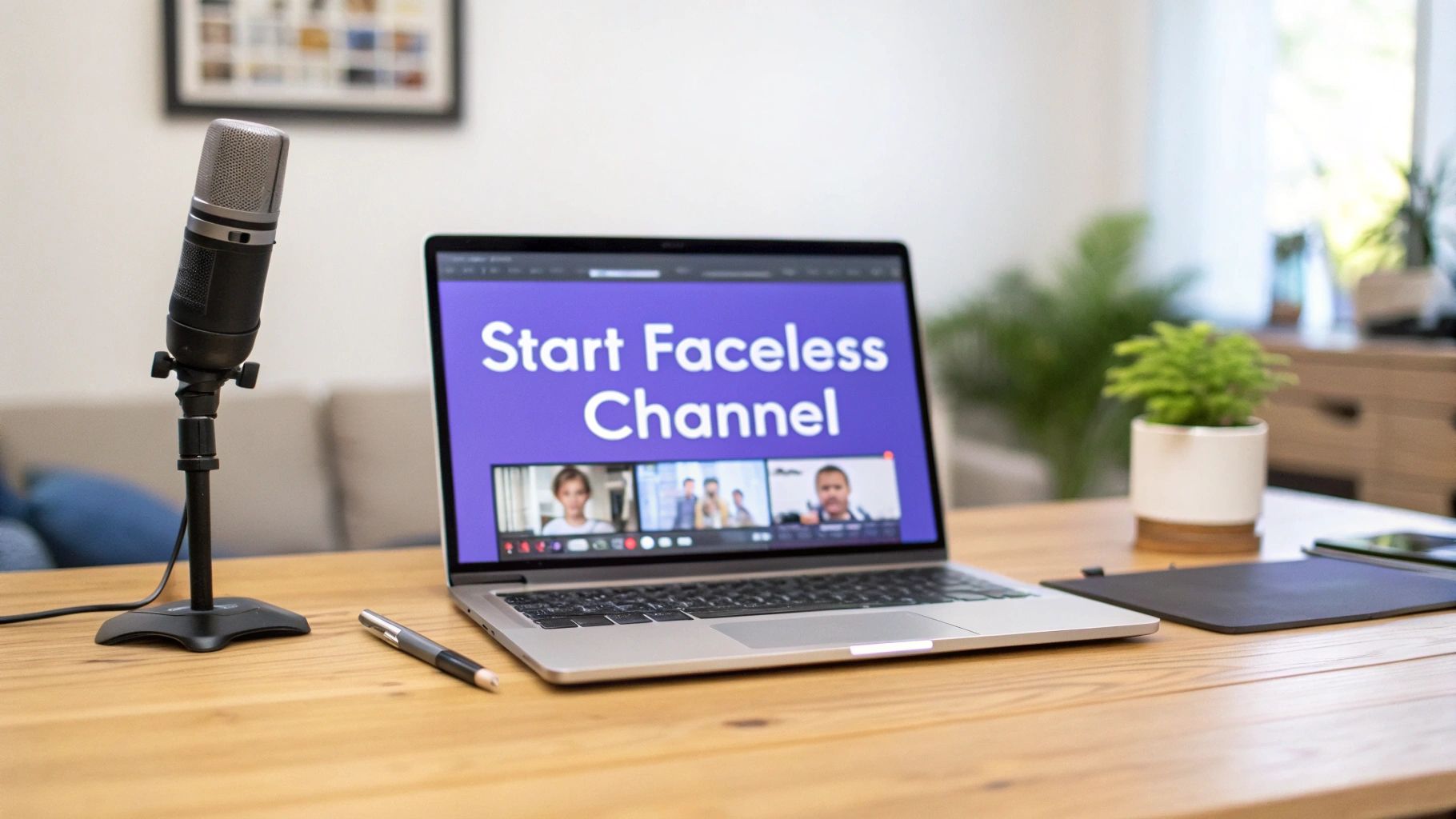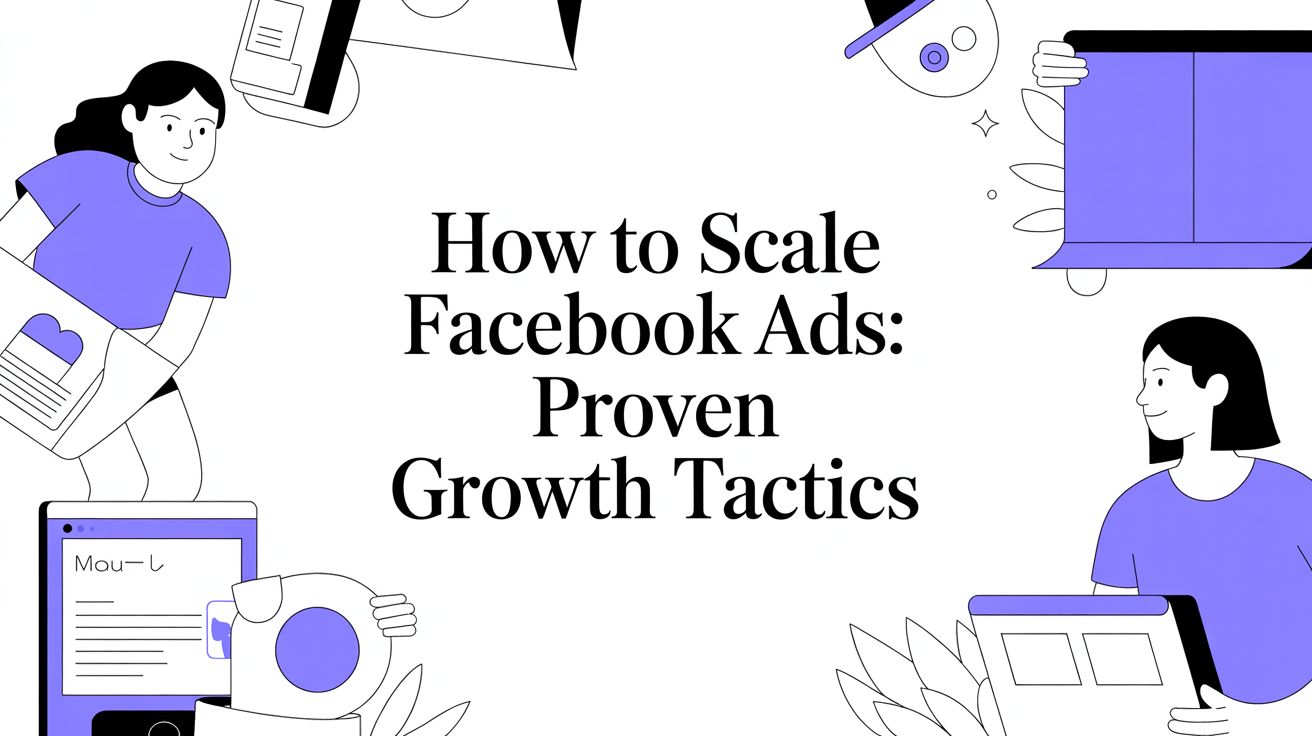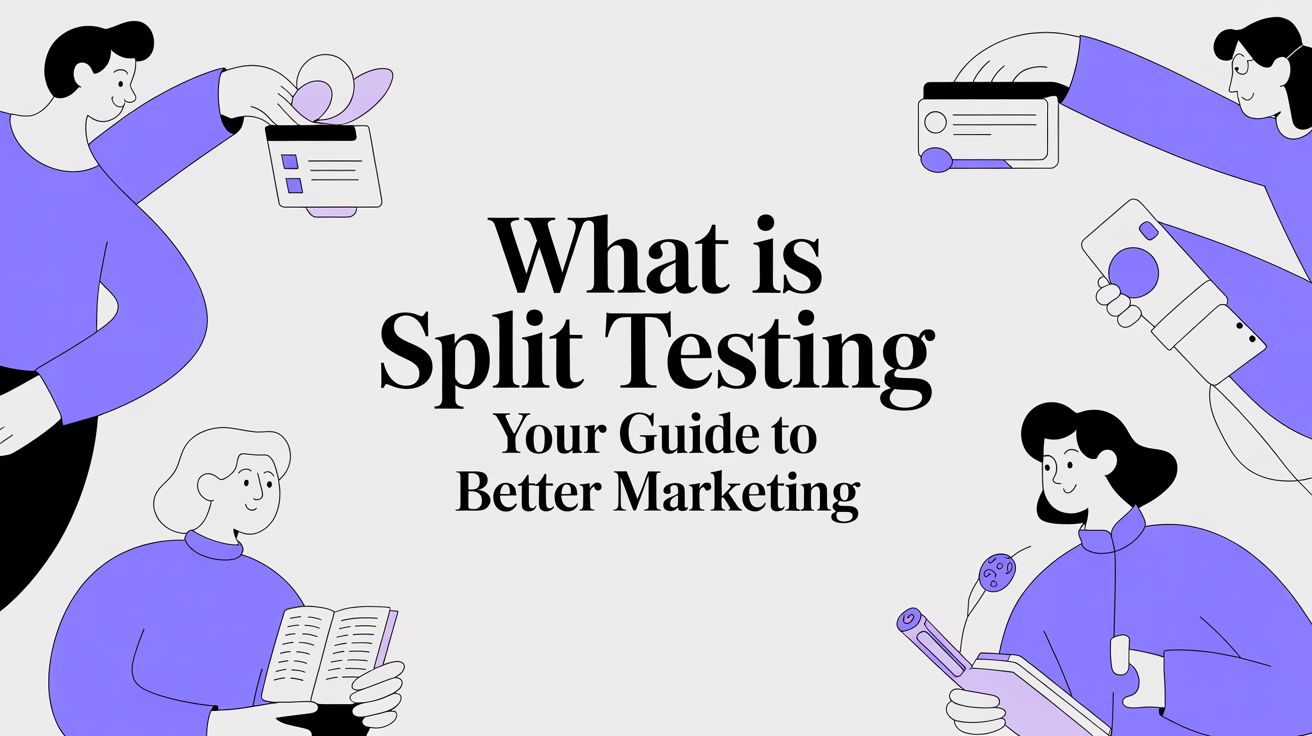Have you ever scrolled through YouTube and stumbled upon a channel with millions of views, only to realize you’ve never seen the creator's face? That’s the magic of a faceless YouTube channel. At its core, it’s about creating compelling content with stock footage, animations, or screen recordings, all tied together with a great voiceover. This strategy is booming because it puts the content, not the creator, front and center.
Why Faceless Channels Are Exploding in Popularity

The idea of building a massive YouTube audience without ever appearing on camera isn't just a niche trend anymore—it's a fundamental shift in how people approach content creation. For a lot of creators, the biggest draw is privacy. Not everyone wants the life of a public figure, and a faceless channel lets you share your knowledge and passion without giving up your personal life.
Beyond privacy, this approach gives you a ton of creative and financial flexibility. You don't need to invest in expensive cameras, fancy lighting rigs, or worry about being "camera-ready." Instead, you can pour all that time, money, and energy into what actually grows a channel: making amazing content.
Before diving deeper, let's quickly recap the main advantages of this model.
Key Benefits of Starting a Faceless Channel
| Benefit | Description |
|---|---|
| Privacy & Anonymity | Share your expertise without becoming a public figure or revealing your identity. |
| Lower Startup Costs | No need for expensive cameras, lighting, or on-screen talent. Your budget goes directly into content quality. |
| Focus on Value | Success depends on the quality of your information, not your on-camera personality. |
| Scalability | It's easier to hire scriptwriters, voice actors, and editors to scale production without you being the bottleneck. |
| Creative Freedom | Explore topics and formats without being constrained by a personal brand or on-screen persona. |
These benefits make it an incredibly attractive path for aspiring creators who want to build a sustainable online business on their own terms.
The Focus on Value Over Personality
When you take your face out of the equation, your content has to deliver. This is the golden rule of successful faceless channels. They succeed by providing incredible value, whether it's through a deep-dive tutorial, a beautifully animated story, or a relaxing guided meditation.
You see this model working brilliantly across so many niches:
- Educational Content: Channels that break down complex topics like history, science, or finance often use slick animations and stock footage to keep viewers hooked.
- Meditation and Relaxation: Here, the entire experience is about soothing sounds and calm visuals. The creator’s face would just be a distraction.
- Gaming: Gamers are there for the gameplay and the entertaining commentary—not necessarily to see who's holding the controller.
- Product Reviews: A well-shot video showing a product from every angle, combined with an expert voiceover, is often far more useful than a standard talking-head review.
This model truly levels the playing field. It proves that a fantastic idea and a commitment to quality can win over a charismatic personality any day.
The real beauty of a faceless channel is that your success is measured purely by the quality of your work. Your brand is built on the substance you provide, creating a loyal audience that values your insights above all else.
The Financial Upside of Anonymity
Many people are surprised by the earning potential of faceless creators. There's a common misconception that you need a strong personal brand to make serious money on YouTube, but the numbers tell a different story. For creators who consistently produce high-quality content, the financial rewards can be huge.
This path has become incredibly popular for those seeking an escape from the pressures of being on camera. In the United States, it's not uncommon for creators to earn an average of $120,226 annually from their content—all without ever showing their face. If you're looking for inspiration, you can find more faceless channel ideas and insights on InVideo.io. It’s clear proof that with the right strategy, anonymity doesn't hurt your bottom line; it can actually help it.
Finding Your Profitable Faceless Channel Niche
Choosing the right niche feels like half the battle—and honestly, it is. This single decision shapes your content, your audience, and how you'll eventually make money more than anything else. Instead of just throwing a list of popular ideas at you, let's walk through a repeatable process for finding a topic that’s not only profitable but also genuinely interesting to you. Believe me, your enthusiasm (or lack of it) will always shine through in your work.
A great niche sits at the sweet spot where three things overlap: your personal interest, real audience demand, and clear ways to earn. If you neglect any one of these, you risk burning out or building a channel that just never gets off the ground. Think of it like a three-legged stool; if one leg is wobbly, the whole thing will collapse.
Gauging Audience Interest and Competition
Before you marry a niche, you have to do some detective work. The goal is to find topics with an active, curious audience that isn't already dominated by a dozen massive channels.
Start with some powerful, free tools. Use Google Trends to see if interest in a topic is growing. Is "AI for artists" on a steady climb while "Photoshop tutorials" is flat? That's a huge clue. A rising trend means you're tapping into a growing pool of potential viewers.
Next, go straight to the source: YouTube. Type your niche ideas into the search bar and see what comes up.
- Who are the top players? Are you seeing giant media companies or individual creators? It’s much easier to find your footing when competing against other individuals.
- What's the video quality like? Could you realistically create content that’s better, more detailed, or just more engaging? Sometimes "better" just means a unique angle.
- Look for content gaps. Are there specific questions within the niche that nobody seems to be answering well? These gaps are your golden opportunities.
For example, a search for "stock market analysis" will bring up a sea of channels run by pros with huge budgets. But a search for "animated philosophy explainers" might show just a few key players, leaving plenty of room for a new creator with a fresh style.
Evaluating Profitability and Content Feasibility
Okay, so you've found a promising niche with a hungry audience. Now it's time to think about the money and the actual work involved. A profitable faceless channel needs a clear path to revenue that goes beyond basic YouTube ads.
Think about the affiliate income potential. A channel reviewing software, financial tools, or even kitchen gadgets has a built-in way to earn commissions. A channel dedicated to ancient history might find this a lot tougher. Always ask: what would my audience actually buy?
A key advantage of faceless channels is their adaptability. Many successful creators use text-to-speech AI or hire freelance voiceover artists. This keeps them completely anonymous and lowers the barrier to entry, as you don't need expensive cameras or mics. You can discover more about these strategies at Descript.com.
You also need to be realistic about how you'll get your visuals. This is a critical step for anyone learning how to start a faceless YouTube channel.
- Stock Footage & Images: Niches like "guided meditation" or "motivational speeches" are perfect for using high-quality stock assets.
- Screen Recordings: If you're doing tech tutorials, software reviews, or gaming, screen capture is your best friend.
- AI-Generated Visuals: Topics in fantasy, science, or abstract concepts are becoming incredibly easy to visualize with AI tools. You can create stunning visuals without ever touching a camera. If you're curious about this, you might find our guide on creating your first AI influencer video helpful.
The Niche Evaluation Framework
To pull this all together, use a simple table to score your top ideas. Be brutally honest with yourself here—a little clarity now can save you months of wasted effort down the road.
| Criterion | Niche Idea 1: Animated History | Niche Idea 2: SaaS Reviews | Niche Idea 3: Lofi Music |
|---|---|---|---|
| Personal Interest | High | Medium | High |
| Audience Demand | Medium | High | Very High |
| Competition Level | Medium | High | Very High |
| Affiliate Potential | Low | High | Low |
| Visual Creation Ease | Difficult | Easy | Medium |
Looking at this quick analysis, "SaaS Reviews" seems like a strong contender. Even with high competition, its massive affiliate potential and easy visual workflow make it very attractive. "Animated History," while personally interesting, would be a huge production headache. This framework helps you look past your passion and make a smart business decision.
Building Your AI-Powered Content Engine
Alright, you've zeroed in on a promising niche. Now for the fun part: building a system to actually create your videos. This is where a lot of people get bogged down, imagining long hours of tedious editing. But this is 2024, and we have AI on our side.
By using the right tools, you can set up an efficient workflow that does most of the heavy lifting. This lets you focus on what really matters—the ideas and quality behind your content. Think of it less like a robot doing your job and more like having a tireless digital production assistant.
Let’s walk through how you can go from a simple script to a polished, ready-to-upload video. The key is to break the process into small, manageable stages: scripting, creating a voiceover, generating visuals, and putting it all together.
From Script to a Voice That Grabs Attention
Every great video starts with a solid script. It's the foundation for everything that follows. While you can absolutely write it yourself, AI can be a great partner for brainstorming or tightening up your first draft. The real game-changer, though, is turning that text into a professional-sounding voice.
Getting a high-quality, human-like voiceover used to be expensive and time-consuming. Not anymore. Tools like ElevenLabs can convert your script into incredibly realistic audio in just a few minutes. You can test out different voices to find the perfect one for your channel’s vibe, whether you need something authoritative, calm, or super energetic. This step alone can save you hundreds of dollars per video compared to hiring a voice actor.
My process is simple: I finalize a script, pop it into an AI voice generator, and download the finished audio file. Just like that, the narration is done. I can knock out the voiceovers for a whole batch of videos in a single afternoon.
This infographic lays out the basic visual workflow in three straightforward steps.
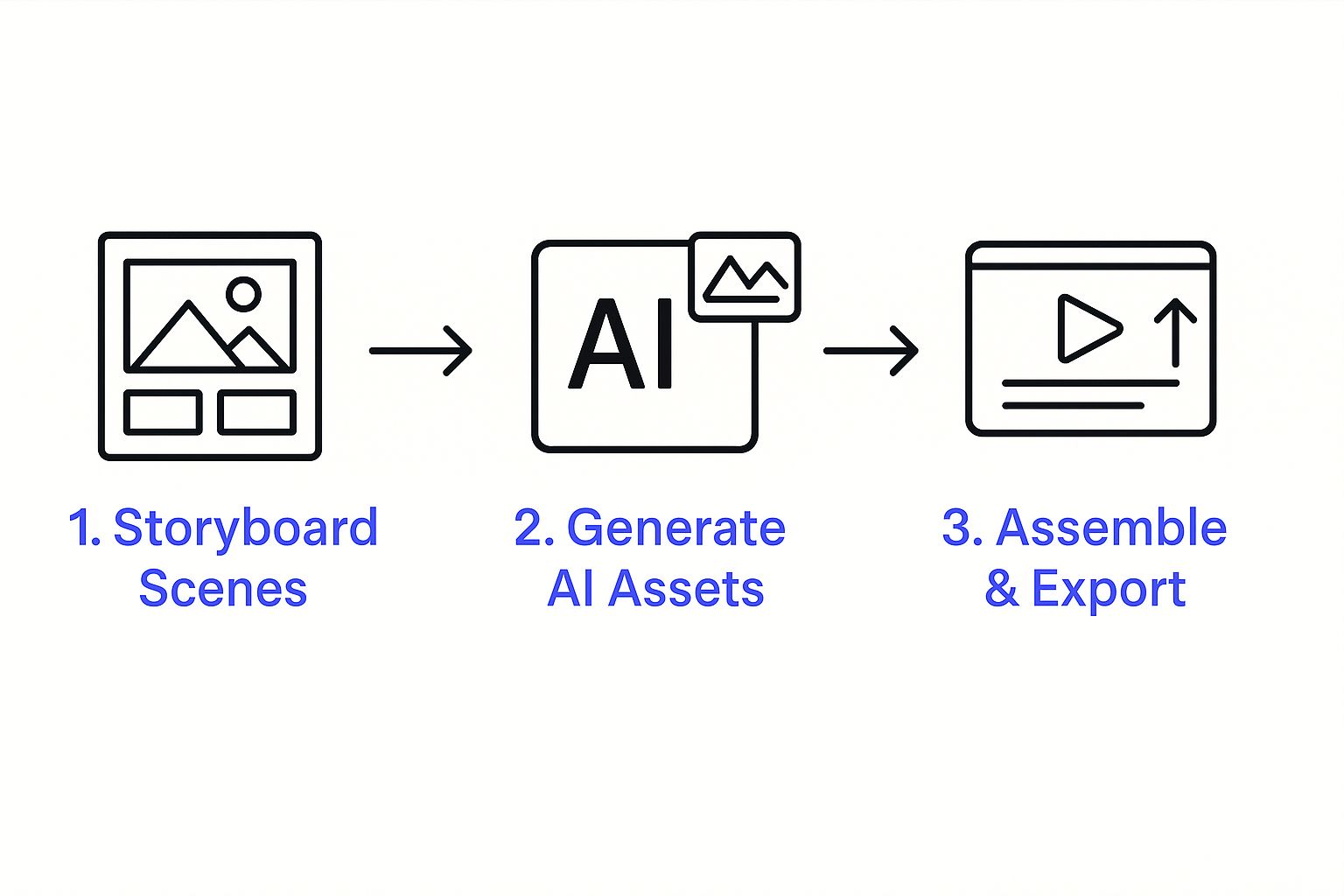
As you can see, it's a simple flow: your storyboard guides what assets you create, and those assets are then assembled into the final video.
Creating Your Visuals with AI
With your audio track ready to go, you need visuals to bring it to life. This is often the biggest roadblock for anyone learning how to start a faceless YouTube channel. In the past, you'd have to spend hours searching through stock footage libraries or get lost in complex animation software. Today, AI makes this part surprisingly easy.
A core piece of this system is using an AI video generator from text. These tools are designed to take your script and automatically find or create relevant video clips, animations, and text overlays to match your narration.
Here’s what that looks like in practice:
- Storyboard Your Scenes: First, I'll quickly map out the visuals for each part of the script. It can be as simple as, "0:05-0:15 - Show an animated chart of stock market growth."
- Generate AI Assets: Next, I use AI image generators like Midjourney to create unique graphics or ask an AI video tool to generate short clips that match my storyboard.
- Source Stock Footage: Finally, I fill in any gaps with high-quality stock video from sites like Pexels or Artgrid. I look for clips that fit the mood and topic I'm covering.
This mix-and-match approach gives you a nearly endless library of visuals without ever touching a camera. If you're focusing on short-form content, you can find a great list of the 12 best YouTube Shorts maker tools that are built specifically for that vertical format.
I’ve learned from experience that the best faceless videos blend different types of visuals. A mix of stock video, custom AI images, and clear on-screen text holds a viewer's attention far better than just one style.
Putting It All Together
The final step is to assemble all your pieces. For this, a tool like Descript is a lifesaver. It’s a totally different kind of video editor that works like a word document—you edit the video simply by editing the text transcript.
You start by uploading your AI-generated voiceover, and Descript transcribes it instantly. From there, you just drag and drop your visuals (stock clips, AI images, etc.) onto the corresponding words in the script. It's a remarkably intuitive way to sync your audio and visuals perfectly.
The best part? You can get rid of filler words ("um," "uh") or awkward pauses just by deleting the text. This can make the editing process up to 90% faster than messing with traditional, complicated timelines. That's a huge win when you’re trying to stick to a consistent upload schedule. Once you’re happy with it, you export the final file, and your video is ready for YouTube.
Optimizing Videos for Views and Subscribers
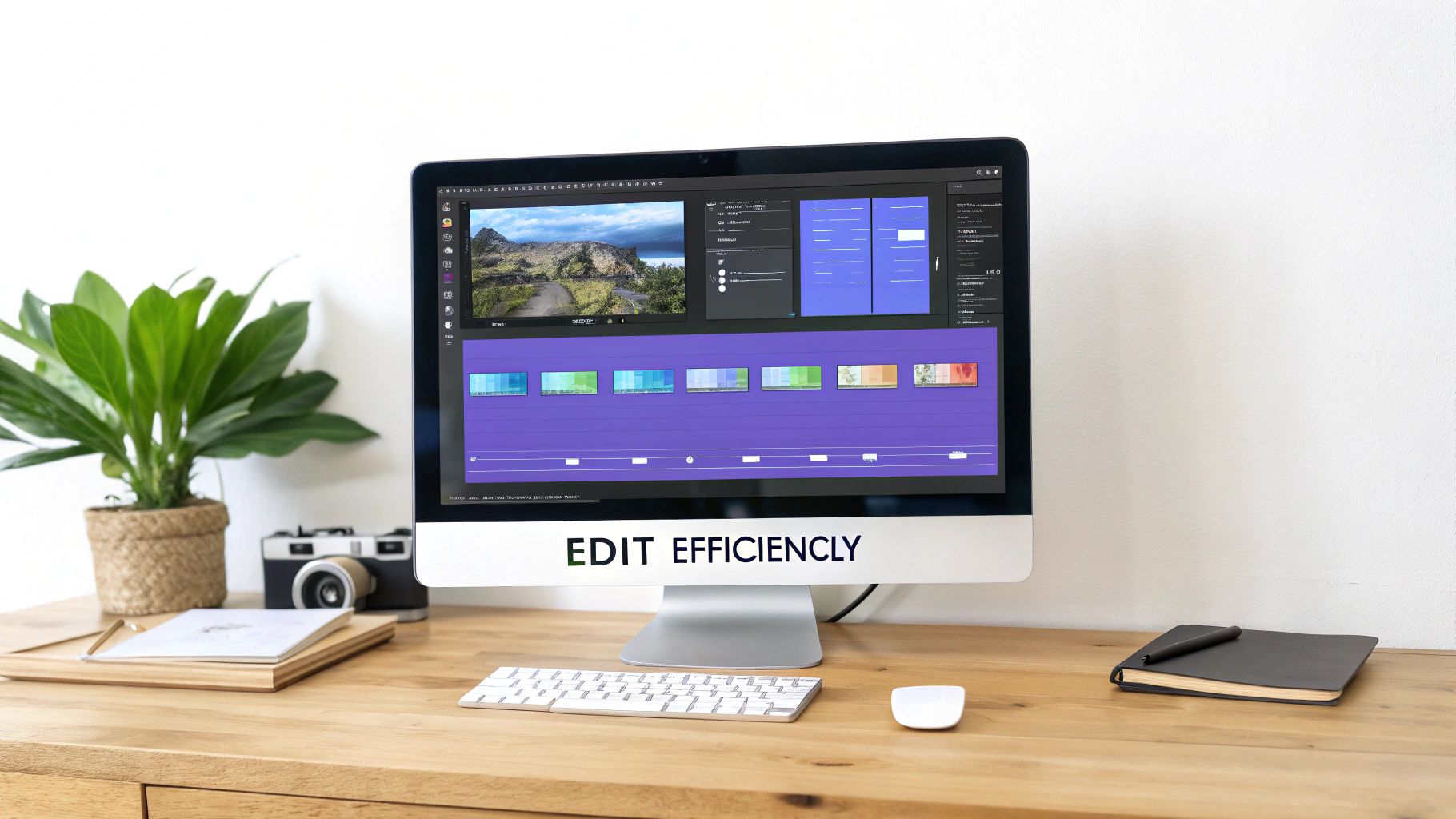
Look, making a great video is a huge win, but it's only half the battle. If nobody finds it, all that hard work was for nothing. This is where we stop thinking like just a creator and start thinking like a savvy marketer.
For faceless channels especially, getting your videos discovered is everything. It all comes down to understanding what your audience is actually searching for and then wrapping your content in a package so irresistible they have to click.
Uncovering What Your Audience Is Searching For
Guessing what people want to watch is a recipe for failure. You need to dig in and find the exact words and phrases they're typing into that YouTube search bar. This isn't optional; it's the foundation of any successful channel.
Your first stop? The YouTube search bar itself. It's a goldmine. Start typing a topic in your niche and watch the autocomplete suggestions. Those are real searches from real people, telling you exactly what they want to know.
To go a bit deeper, I always recommend these simple tactics:
- Spy on the Competition: Check out the top-performing videos in your niche. What keywords are they using in their titles and descriptions? Browser extensions like TubeBuddy or vidIQ can show you the exact tags they're using. It's like getting a peek at their playbook.
- Hang Out Where Your Audience Is: Dive into Reddit threads, Quora questions, or niche forums. The questions people are asking are basically content requests. They're telling you exactly where the demand is.
- Check the Vibe with Google Trends: Use Google Trends to compare a few of your video ideas. You can see if a topic is a flash in the pan or has real, sustained interest. You want to build on trends that are growing, not dying.
Putting together a solid list of these keywords gives you a roadmap for content that people are actually looking for, which seriously boosts your odds of being discovered.
Writing Titles and Descriptions That Work
Your title and thumbnail are your one-two punch for getting clicks. The title has to be catchy enough to stop the scroll but also clear enough so people know what they're getting into. A killer formula I've seen work time and time again is combining your main keyword with a hook that sparks curiosity or emotion.
So, instead of a snooze-fest title like "Stock Market Tips," you'd go with something like "5 Stock Market Mistakes That Keep Beginners Poor." It’s got the keyword ("stock market") and hits an emotional trigger. It works.
Your description is your next shot at convincing both viewers and the YouTube algorithm that your video is worth watching.
Your most valuable real estate is the first two or three sentences of the description. This is what shows up in search results, so it needs to clearly sell the video while naturally including your main keyword.
The rest of the description is for adding context. Drop in links to resources, your social media, or other relevant videos. I also highly recommend using timestamps for longer videos. It helps viewers find what they need and signals to YouTube that you're providing a great user experience.
Creating Thumbnails That Demand a Click
As a faceless creator, your thumbnails have to work overtime. You don't have an expressive face to rely on, so you need to become a master of visual persuasion.
The goal is to be clear, bold, and intriguing. Use high-contrast colors—think yellow on black or bright blue on orange. They just pop on the screen. Your text needs to be huge and easy to read, even on a tiny phone screen. A few powerful words that summarize the video's core promise is all you need.
Think of your thumbnail as a tiny billboard for your video. It needs to make someone curious enough to click. When your title, thumbnail, and video content all align perfectly, you create a powerful combination that turns casual viewers into dedicated subscribers.
How to Monetize Your Faceless Channel

Alright, let's get to the fun part: making money. Hitting the requirements for the YouTube Partner Program (YPP) and seeing that first ad payment is an incredible feeling. But I've seen too many creators make the mistake of stopping there.
Relying solely on ad revenue is like building a house on a shaky foundation. Ad rates go up and down without warning, which means your income can be a rollercoaster from one month to the next.
The most successful creators, especially in the faceless content world, treat their channel like a real business. They build multiple income streams that create a much more stable—and often much more profitable—operation than AdSense alone could ever offer.
Thinking Beyond YouTube AdSense
First, you need a mental shift. Stop seeing your videos just as content. Start seeing them as assets. Each video is a potential salesperson working for you 24/7, capable of generating money in several different ways.
The real magic happens when you weave these monetization methods directly into the value you're already giving your audience.
This is where a faceless channel has a huge advantage. Since your content is laser-focused on a specific niche, it’s much easier to pinpoint products or services that your viewers will actually want and appreciate.
Unlocking Earnings with Affiliate Marketing
For most creators, affiliate marketing is the most natural next step after AdSense. The idea is simple: you recommend a product you genuinely like, and if someone buys it through your unique link, you get a cut of the sale. It costs the buyer nothing extra.
Here’s how to get it right:
- Be Authentic: This is non-negotiable. Only promote things you've personally used or deeply researched. Your audience follows you for your expertise; don't burn that trust for a quick buck.
- Keep it Relevant: The connection should be obvious. If your channel reviews software, become an affiliate for that software. If you summarize books, link to them on Amazon or Audible. It just makes sense.
- Show, Don't Just Tell: The best affiliate plugs don't feel like ads. Create a tutorial showing the product in action or a review explaining how it solves a real problem. That’s far more powerful than just dropping a link.
In many high-value niches like tech, finance, or software, it's not uncommon for affiliate income to blow past AdSense revenue.
Creating and Selling Your Own Products
This is the ultimate level-up. Instead of earning a small commission, you keep 100% of the profit. Selling your own digital products is one of the most powerful ways to monetize, and it’s a perfect fit for faceless channels.
You've already proven you have valuable knowledge. Now, you can package that knowledge into a premium product.
Think about it:
- A channel focused on historical deep dives could sell beautifully designed digital map prints or detailed event timelines.
- A productivity channel could sell custom Notion or Asana templates.
- A personal finance channel could offer a comprehensive budgeting spreadsheet that goes way beyond the basics.
Some faceless channels have seen incredible success with this model. Take 'Improvement Pill,' a channel on personal development. It reportedly pulled in over a million views in one month, earning upwards of $4,000 in that period by combining different income streams. This proves you don't need to show your face to build a profitable brand.
This strategy transforms your channel from a simple content feed into a genuine brand that has a direct, commercial relationship with its audience.
Securing Sponsorships and Brand Deals
Don't fall into the trap of thinking you need a massive subscriber count to land brand deals. These days, many brands would rather partner with a channel that has a smaller, super-engaged niche audience than one with millions of passive viewers.
If you have a dedicated community, you have leverage.
Sponsorships can range from a quick "This video is sponsored by..." shout-out to a full, integrated product review. The trick is to find brands that are a perfect match for your content and your viewers' interests. A good partnership can even open doors to more advanced projects, like getting paid to create slick AI video ads for a brand partner.
Monetization Strategy Comparison
Choosing the right mix of monetization strategies depends on your channel's niche, audience size, and how much work you're willing to put in. Each method has its pros and cons.
| Strategy | Income Potential | Effort Level | Best For |
|---|---|---|---|
| YouTube AdSense | Low to Medium | Low | All channels, once eligible. |
| Affiliate Marketing | Medium to High | Medium | Channels in product-heavy niches (tech, beauty, finance). |
| Digital Products | High to Very High | High | Channels with deep expertise and an engaged community. |
| Sponsorships | Medium to High | Medium | Channels with a highly targeted, niche audience. |
Ultimately, the goal isn't to pick just one. By combining AdSense, affiliate marketing, your own products, and sponsorships, you create a diversified financial engine. This is how you turn a faceless YouTube channel from a side project into a sustainable, profitable business.
Got Questions About Going Faceless? Let's Clear Things Up.
Even with the best game plan, it's totally normal to have some last-minute questions buzzing around in your head. I get it. Before you dive in, you want to be sure you're on the right track.
So, let's tackle some of the most common concerns I hear from creators who are right where you are now. These are real questions from people who were once in your shoes, and getting them answered is the final step before you can start creating with confidence.
Can I Really Get Monetized Without Showing My Face?
Yes, 100%. This is probably the biggest myth holding people back. YouTube doesn't care if you're on camera; it cares about the value and originality of what you create.
The platform's monetization policies are all about whether your content is transformative. This means you're adding something new—your own commentary, unique editing, an original script, or a fresh perspective. As long as you’re not just re-uploading other people’s content or creating low-effort, repetitive videos, you are absolutely eligible for the YouTube Partner Program (YPP).
Think about it: some of the highest-earning channels on the platform are completely faceless. This is all the proof you need that what truly matters to the algorithm, the audience, and the advertisers is high-quality, engaging content.
Your channel’s YPP eligibility comes down to the unique value you provide. If you're writing original scripts, putting your own spin on edits, and offering a fresh take, you're playing by YouTube's rules—face or no face.
What's the Bare Minimum Equipment I Need to Start?
This is one of the best parts of starting a faceless channel: the startup cost is incredibly low. You get to skip all the expensive gear that traditional vloggers need.
Your single most important tool is a computer that can handle basic video editing. It doesn't need to be a beast of a machine, just something reliable enough that it won't crash every time you try to render a video.
Here’s a simple breakdown of what you need versus what’s nice to have:
- The Absolute Essential: A decent computer. That’s it.
- For Your Own Voice: A good USB microphone will make a world of difference. You can’t go wrong with popular options like a Blue Yeti or Rode NT-USB Mini. It's a small investment with a huge payoff in audio quality.
- For AI Voiceovers: If you're using an AI voice, you don't even need a mic. Your computer is literally all you need to get started.
- Software: You can start for free with incredibly powerful editors like DaVinci Resolve or the free version of apps like CapCut.
You get to forget about cameras, lighting rigs, tripods, and fancy backdrops. That money can be put to much better use on things that will actually help a faceless channel grow, like a subscription to a premium stock footage site.
How Do I Build a Connection With My Audience if They Can't See Me?
This is a fantastic question because connection is everything on YouTube. When you don't have a face, your channel's "personality" has to come through in other ways. Your brand isn't you—it's the unique style and consistent quality you deliver.
You forge that connection through:
- Your Writing Style: Is it funny? In-depth? Sarcastic? The tone and perspective in your scripts become your personality.
- Your Editing Choices: The rhythm of your cuts, your sound design, and the overall visual aesthetic all shape how your channel feels to a viewer.
- A Consistent Voice: Whether it’s your own voice or a specific AI voice you use every time, this becomes a familiar and recognizable element of your brand.
But the real community-building magic happens in the comments. Seriously. Make it a mission to engage with your audience. Respond thoughtfully, pin great comments, and ask questions to get conversations going.
Don't forget to use the Community tab, either. Posting polls, sharing behind-the-scenes tidbits, or asking for video ideas makes your audience feel like they're part of the journey. Your authenticity shines through in the value you provide and the community you build around it.
Are AI Voices Allowed for YouTube Monetization?
Yes, high-quality AI voices are generally fine for monetization, but there’s a big "if." The content itself must be original and add value. YouTube’s rules are aimed at weeding out low-effort, auto-generated junk that clogs up the platform.
If you’re writing original scripts from scratch and using a realistic AI narrator for your own unique video—one that features your own visual storytelling and commentary—you are typically well within the guidelines. The key is that the AI voice is just one piece of a much larger, transformative work you've created.
Just be sure to avoid cheap, robotic-sounding text-to-speech programs. It’s worth investing in a quality AI voice generator. Always pair the voiceover with well-edited, relevant visuals to make it crystal clear that your content is unique and not just "reused" or "programmatically generated."
Ready to bring your video ideas to life without ever stepping in front of a camera? With Sprello, you can create high-performing, UGC-style videos using 100% AI influencers. It’s the perfect way to produce stunning visual content for your faceless channel quickly and affordably. Start your free trial today at sprello.ai.
